双手安全培训 Hand Safety Training 57
- 格式:pdf
- 大小:1.91 MB
- 文档页数:57
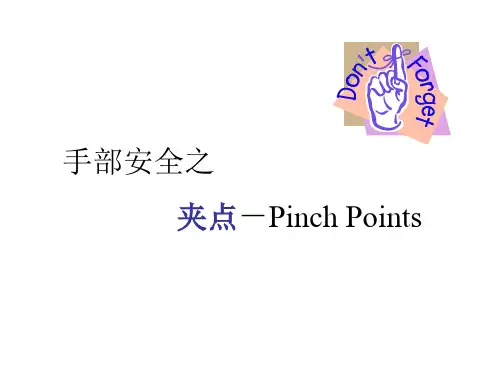


手部安全培训 hand safety training安全意识要变化要我安全,我要安全, 我懂安全,我会安全.http://tomorrow.akzonobel.intrahttp://tomorrow.akzonobel.intraActivity Brief Description 小活动“假如我缺了一根手指”, 手体验活动, “If I loss one of my fingers” 描述: 通过模拟人体缺少一根手指的情景让 员工来体验由于失去手指对所人们日 生活及工作所造成的不便与影响, 建 立反面教材, 从而提高大家保护双手 的意识。
Description: Let employee Experience in group how they can live their life and do their work with one finger missing. Let them feel what is the importance of the hand/fingershttp://tomorrow.akzonobel.intraExperience 1:How you can wear shoes without the pollex? 活动1:你是否可以在没有拇指 的情况下系鞋带?缺少了大拇指, 生活将 会变得不方便,做起 事来没有效率。
Very troublesome without the pollexhttp://tomorrow.akzonobel.intraExperience 2: Hands shadow puppets 活动2:手影游戏 目的:体现手的作用,同时亦体现团队合作精神。
造影要求:该节目由参加培训员工组成团队,比赛时,参赛 团队在下页的6个图案中选取2个图案,每个图案都必须2人共 同完成。
http://tomorrow.akzonobel.intraExperience 2: Hands shadow puppets 活动2:手影游戏http://tomorrow.akzonobel.intraExperience 2: Hands shadow puppets 活动2:手影游戏http://tomorrow.akzonobel.intraHand injuries photos 一些手部受伤照片What If….What if…..It’s sharp? Watch ‘em, don’t lose ‘em. Your ring gets caught? Watch ‘em, don’t lose ‘em.http://tomorrow.akzonobel.intra培训目录Training course list1。
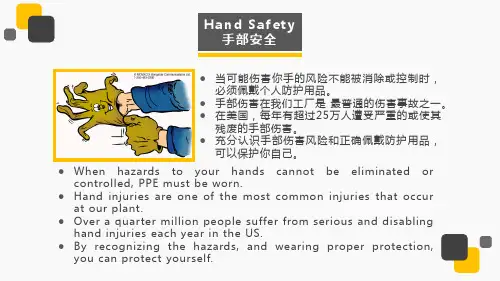
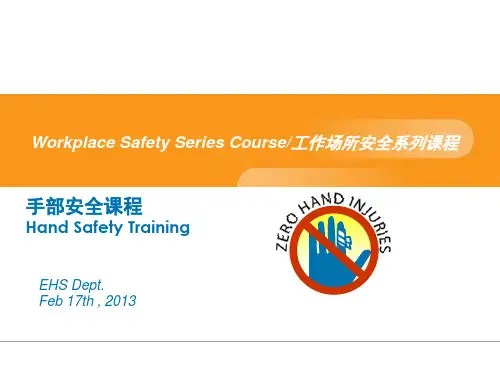
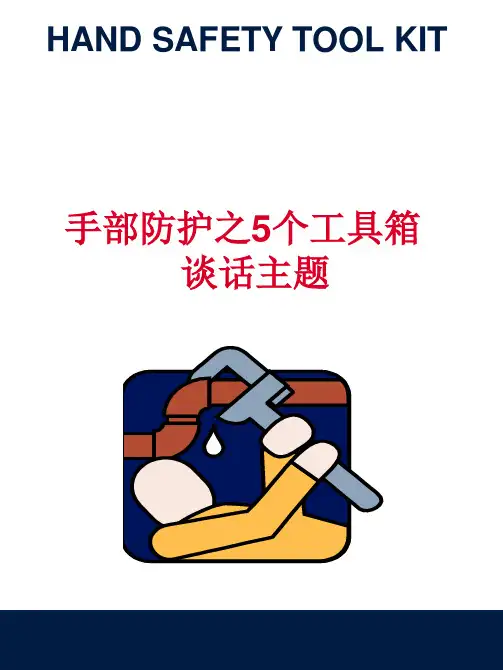

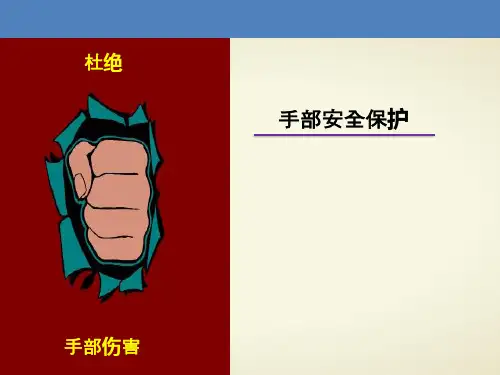
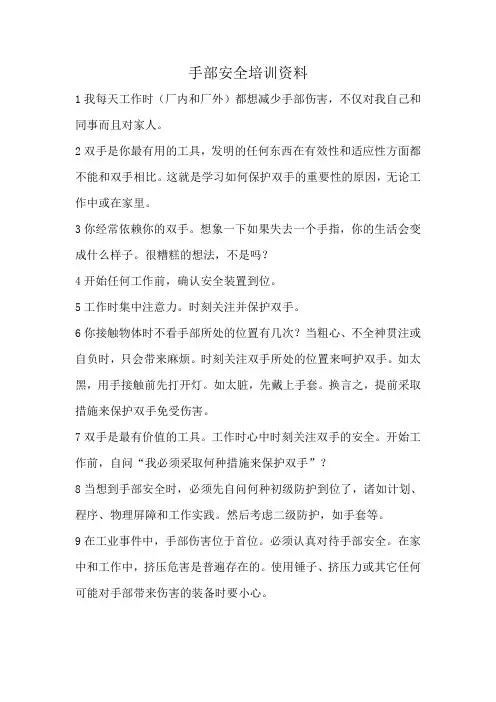
手部安全培训资料1我每天工作时(厂内和厂外)都想减少手部伤害,不仅对我自己和同事而且对家人。
2双手是你最有用的工具,发明的任何东西在有效性和适应性方面都不能和双手相比。
这就是学习如何保护双手的重要性的原因,无论工作中或在家里。
3你经常依赖你的双手。
想象一下如果失去一个手指,你的生活会变成什么样子。
很糟糕的想法,不是吗?4开始任何工作前,确认安全装置到位。
5工作时集中注意力。
时刻关注并保护双手。
6你接触物体时不看手部所处的位置有几次?当粗心、不全神贯注或自负时,只会带来麻烦。
时刻关注双手所处的位置来呵护双手。
如太黑,用手接触前先打开灯。
如太脏,先戴上手套。
换言之,提前采取措施来保护双手免受伤害。
7双手是最有价值的工具。
工作时心中时刻关注双手的安全。
开始工作前,自问“我必须采取何种措施来保护双手”?8当想到手部安全时,必须先自问何种初级防护到位了,诸如计划、程序、物理屏障和工作实践。
然后考虑二级防护,如手套等。
9在工业事件中,手部伤害位于首位。
必须认真对待手部安全。
在家中和工作中,挤压危害是普遍存在的。
使用锤子、挤压力或其它任何可能对手部带来伤害的装备时要小心。
10检查物体的裂缝、锯齿边缘、毛刺、粗糙或光滑表面。
戴上手套或采取其它预防措施来保护双手。
处理前擦去油的、湿的、滑的和脏的东西。
11拿物品前未检查它的危害经常导致刺伤、扎伤和割伤。
仅花费几秒钟的时间检查,从长远看就可节省许多时间和痛苦。
例如,搬起带锯齿边缘的箱子前,戴双皮手套可保护双手。
同样,检查可导致物体滑落和弄脏双手的油的、湿的、脏的表面。
处理前擦干净并戴上合适的手套。
12注意拇指。
尽管拇指看起来有点短而粗硬,但他们确实比你想象的更重要。
不信你尝试一下系鞋带或开门和启动车时不用拇指会怎样。
拇指是一个有用的工具—一步错步步错。
因此选择正确的、状况良好的工具开展工作并正确使用它。
13集中精力干工作,任何分心都可导致犯错割到手。
使用刀具或处理带锐边物品时,戴防割手套。


安全培训教材英文Safety Training ManualIntroductionThe Safety Training Manual aims to equip individuals with the necessary knowledge and skills to ensure a safe working environment. This manual provides comprehensive guidelines on various safety protocols, procedures, and best practices to ensure the well-being of both employees and the organization as a whole.Chapter 1: Workplace Hazards1.1 Types of HazardsIn this section, we will discuss the different types of workplace hazards that individuals may encounter. These hazards include physical, chemical, biological, and ergonomic hazards. Understanding these hazards is crucial in preventing accidents and injuries in the workplace.1.2 Risk AssessmentThis section focuses on the importance of conducting a thorough risk assessment to identify potential hazards in the workplace. It provides step-by-step guidance on how to assess risks and implement appropriate control measures to minimize or eliminate these risks.Chapter 2: Personal Protective Equipment (PPE)2.1 Introduction to PPEThis section provides an overview of personal protective equipment (PPE) and its significance in ensuring worker safety. It explains the different types of PPE and their specific applications in various industries.2.2 Selection and Proper Use of PPEHere, we outline the criteria for selecting suitable PPE and provide guidelines on how to properly use and maintain personal protective equipment. This includes instructions on fitting, inspection, cleaning, and storage of PPE.Chapter 3: Emergency Preparedness3.1 Emergency Response PlanThis section discusses the importance of having an emergency response plan in place. It provides a framework for developing an effective plan, including emergency escape routes, designated assembly areas, and emergency contact information.3.2 Fire SafetyFire safety is of utmost importance in any workplace. This section delves into fire prevention, evacuation procedures, fire extinguisher usage, and the importance of fire drills and training.Chapter 4: Workplace Ergonomics4.1 Ergonomic PrinciplesWorkplace ergonomics plays a significant role in preventing musculoskeletal disorders and optimizing worker productivity. This sectionintroduces ergonomic principles and provides practical tips to promote proper posture, reduce strain, and create a comfortable working environment.4.2 Ergonomic Risk AssessmentHere, we delve into the process of conducting an ergonomic risk assessment to identify potential hazards that may lead to musculoskeletal disorders. It explains how to implement ergonomic controls and modifications to mitigate these risks.Chapter 5: Electrical Safety5.1 Electrical HazardsThis section covers the potential hazards associated with electricity and provides guidelines on how to identify and mitigate these risks. Topics include electrical shock, electrical burns, and appropriate safety measures when working with electrical equipment.5.2 Electrical Safety PracticesHere, we explore safe work practices when dealing with electrical equipment and systems. It includes guidance on lockout/tagout procedures, proper use of personal protective equipment, and the importance of regular equipment maintenance.Chapter 6: Chemical Safety6.1 Hazardous ChemicalsThis section addresses the hazards associated with various chemicals used in the workplace. It covers proper handling, storage, and disposalpractices, as well as the importance of accurate labeling and understanding Material Safety Data Sheets (MSDS).6.2 Personal Protective MeasuresTo ensure safety when working with hazardous chemicals, this section provides guidelines on selecting and using appropriate personal protective equipment. It emphasizes the significance of proper ventilation, eye protection, and respiratory protection.ConclusionThe Safety Training Manual serves as a comprehensive guide to instill a culture of safety within the workplace. By understanding and implementing the protocols and best practices outlined in this manual, individuals can actively contribute to preventing accidents, injuries, and occupational hazards. Remember, safety is everyone's responsibility. Let's work together to create a secure and protected working environment.。
美团2022五月份安全培训答案安全培训(safety training)是安全生产管理工作中一项十分重要的内容,它是提高全体劳动者安全生产素质的一项重要手段。
所谓安全培训,一般是指以提高安全监管监察人员、生产经营单位从业人员和从事安全生产工作的相关人员的安全素质为目的的教育培训活动。
一、填空题:(每空2分,共20分。
把正确答案填在括号内。
)(1)安全就是指生产系统中人员免受不容忍受(危险)的危害。
(2)安全生产方针是(安全第一),(预防为主),(综合治理)。
(3)高处作业就是所指凡在掉落高度基准面(2米)以上,有可能掉落的高处展开的作业。
(4)无视规章制度,明知故犯的行为,往往都是导致事故发生的(人为因素)。
(5)“机构母舒氏运转”,“采用安全装置失灵”,往往都就是引致事故出现的(物的因素)。
(6)生产经营单位的厂规厂纪就是确保安全生产的(关键措施)。
(7)室内空气中二氧化碳含量达到(10%)时,就能使人不省人事、呼吸停止甚至死亡。
(8)检修设备时,必须摆(有人工作,严禁合闸)的安全标志牌,以告诫人们特别注意。
二、判断题(每小题2分,共50分。
在正确的括号内打“√”,在错误的括号内打“x”)(对)1、安全生产就是所指在劳动生产过程中消解可能将引致人员伤亡、职业危害或设备、财产损失的因素,确保人身安全、身心健康和资产安全。
(对)2、生产经营单位发生的生产安全事故的原因是:人的不安全行为,物的不安全状态,管理上的缺陷。
(对)3、“三不危害”就是:不危害自己、不危害他人、不被他人危害。
(错)4、车间内的电气设备发生故障,应立即请安全生产管理人员来检修。
(对)5、根据分析,导致事故的“人为因素”主要就是违章操作和违背劳动纪律两方面。
(错)6、生产经营单位里发生的生产安全事故的原因是多方面的,但主要是“物的因素”(对)7、在生产过程中,穿拖鞋、凉鞋、高跟鞋、系则围巾以及留著发辫而又不将其放进工作帽内的`犯罪行为属违章行为。
双手安全培训Hand Safety TrainingHand Injuries account for most of our serious injuries. Safety incidents have long been a major source of injuries. We must reduce these so we must target the specific injury sources.手部伤害在各类重大事故中占了大部分比例,安全事故是导致伤害的主要源头。
一定要瞄准具体的伤害源头以减少类似事故的发生Can we take the same approach to hand safety that we took towards safety -Prevention first,protection second?能否以同样的安全的方式来对待手部安全—先预防,后保护?Take a moment to hold your hands out in front of you. Look at them. They are the only two hands you will ever have. Do you have any scars?伸出双手观察一下,人这辈子就只有两只手,看看上面有没有伤疤?It has been estimated that almost 20% of all disabling accidents on the job involve the hands. Without your fingers or hands,your ability to work and live an active life,would be greatly reduced.据统计20%的伤残事故都发生在手上。
没有了手或手指头,个人工作及生活的积极性将会大打折扣。
Image what will change your life you you lost your hands想象一下没有了双手,你的生活将会是怎样的?Human hands are unique. No other creature in the world has hands that can grasp,hold,move,and manipulate objects like human hands. They are one of your greatest tools and assets. And,as such,must be protected and cared for.人类的手是独一无二的。
世界上没有任何生物具备可以像人类一样灵活自如地抓提掌控物体之双手。
双手就是最好的工具和资产,因此必须要好好保护才行。
How would you answer this question?请回答如下问题:“What is the most used tool inindustry?”工业领域里最常用的工具是什么?Hammer 锤子Screwdriver 改锥Drill 电钻Crescent wrench 扳手Pliers 钳子The most used tool is:最常用的工具是:Try writing without using your thumb没有拇指写字试试看Try holding a hammer with only two fingers只用两根手指头握一下锤子试试看Try using any man made tool without your hands不用手使用任何其它人造工具试试看Hand protection is important because our hands are exposed to so many hazards in the workplace手经常处于多种风险当中,因此保护双手尤为重要General Requirements总体要求Requirements for Hand Protection对手部防护的要求We shall train and require employees to use appropriate hand protection when employees’ hands are exposed to hazards such as those from skin absorption of harmful substances;severe cuts or lacerations;severe abrasions;punctures;chemical burns;thermal burns;and harmful temperature extremes.我们将针对手部接触有害物质、割伤、划伤、挫伤、刺伤、化学烧伤、烫伤及高温伤害等危害进行相关培训Blades which can cut or amputate your fingers or hands.锋利的片状物可切断手或手指头-Use push sticks and tongs to keep your hands away from blades or hot objects.用棍子或钳子把薄片或其它高温物体挪开-Cut away from the body when using a knife用刀具切割时离身体远一点Rough surfaces and sharp edges which can scrape or cut the skin. 粗糙表面及锋利边角会刮伤或切入皮肤-Use a grinder or file to remove the rough surface.用磨光机或挫刀磨平表面Machinery which can pinch or crush your fingers.机器会夹伤或压碎手指-Make certain the equipment has been locked out and all energy sources has been disconnected.作业前设备上锁,切断水电气等。
-Machine guards in place and operable设有可操作的设备防护挡板Consider the force of gravity.考虑重力影响-Keep your hands out from under suspended or elevated loads. 不要把手放在悬空物体或载荷之下Pry bars or supports slipping/ failing 撬棍或支架滑落Missing the target with a hammer 锤击偏位-Keep your hands out of the line of fire不要把手放在触发路径上Chemicals which can irritate or burn the skin造成皮肤刺激或烧伤的化学品Make certain that the gloves that your have on are the correct ones.确保防腐手套选用得当Heat and Cold 骤冷骤热-Cool off hot material before handling it,even gloved,erect a barrier against cold and hot surfaces).受热物体冷却后方可加工,即使戴了手套也要在冷热物体的表面加一层防护层A pinch point can exist anytime two objects come together. Anexample is where a closing door and door frame come together.任意两个物体放在一起就可以形成夹接点,例如,关门时门和门框就形成了夹接点Here are some actual cases of pinch points:如下为一些夹接点的实际例子:An Iron worker injured his fingers when a beam shifted and pinched his fingers between the beam and the concrete floor.某钢结构工人在安装横梁时发生偏转,手指夹在了横梁与混凝土之间A pipe fitter put his hand over the end of a pipe. A helper moved another pipe which hit the pipe fitter’s hand.某管工把手放在管子末端,此时辅工正在挪动另一管子,结果碰在了管工的手上In both examples,gloves did little to prevent the injury. The key to preventhand injuries as a result of pinch points is to think about where your handsare placed and avoid them all together. To do so requires hazard identification.上述两种案例当中手套基本不起保护作用,防止夹接风险的关键是要避免把手放在不该放的位置上,因此需要进行风险确认。
In order to properly position your hands,you must first recognize the hazard and then develop a plan to help keep your hands from being injured. This requires thought and action.为了把手放在正确的位置,必须要认识风险且根据风险制定一套方案来避免伤害,需要思行结合。
Use equipment to move heavy materials when possible,not manual means.尽量利用设备搬运重物,避免徒手搬运The best safety device for your hands is to use your mind.用思想左右您的双手才是最安全的防护方式By being alert and aware you can avoid poor positioning of your hands,keep them out of the areas that will harm one of your most valuable tools:your Hands.只有时刻保持思想上的警惕才可避免将双手置于不当位置,请用思想意识来保护最珍贵的工具:双手。